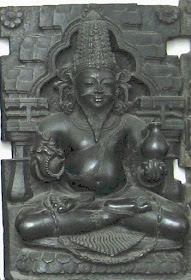Queen Shivali from the Mahajanak Jataka
Ajanta Caves,Gupta Period, 5th Century CE
Besides painting innumerable Buddhas and Bodhisattvas, the Ajanta artists have left a variety of sensuous women. Queen Sivali is certainly one of them. Young, voluptuous, bejewelled, half nude, she is the ideal of feminine beauty in Indian art. Since women were seen as representing the Nature, they had to be well endowed in their beauty. Queen Sivali belongs to the category of Yakshini ( the fertility goddess ).
But the queen is not free from the pangs of life. Her husband, King Mahajanak of Mithla, has just announced his intention to abdicate the throne and to take Sanyas ( to renounce the world and to become a buddhist monk). The Queen is perplexed by the decision. Her well kept hair are becoming dishevelled; her string of pearls has started swaying as she takes deep breath (notice the two pearl strings in front of her stomach ). She looks at her husband in half disbelief.
Life can be uncertain at the best of the times. Sorrow can come suddenly. The cheeze can be moved without any notice. Even the rich and the beautiful, even the powerful and regal are subject to the whims and caprice of life and Time.



























